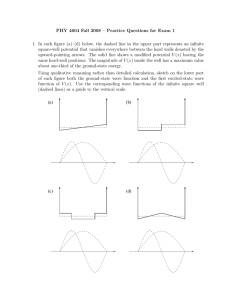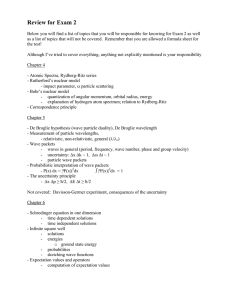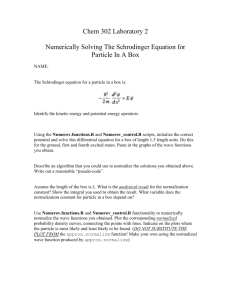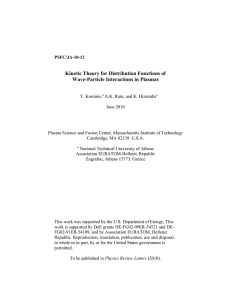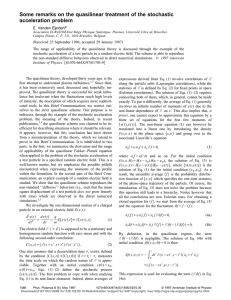PSFC/JA-08-36 NONLINEAR THEORY OF CYCLOTRON RESONANT WAVE-PARTICLE INTERACTIONS: ANALYTICAL RESULTS
advertisement
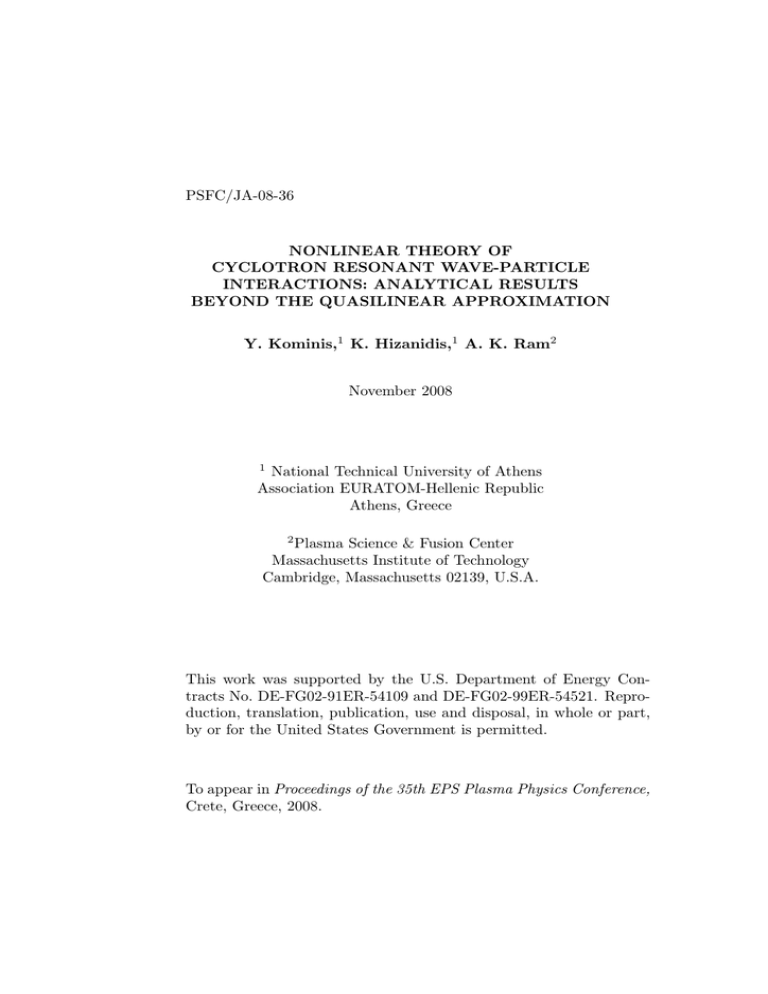
PSFC/JA-08-36 NONLINEAR THEORY OF CYCLOTRON RESONANT WAVE-PARTICLE INTERACTIONS: ANALYTICAL RESULTS BEYOND THE QUASILINEAR APPROXIMATION Y. Kominis,1 K. Hizanidis,1 A. K. Ram2 November 2008 1 National Technical University of Athens Association EURATOM-Hellenic Republic Athens, Greece 2 Plasma Science & Fusion Center Massachusetts Institute of Technology Cambridge, Massachusetts 02139, U.S.A. This work was supported by the U.S. Department of Energy Contracts No. DE-FG02-91ER-54109 and DE-FG02-99ER-54521. Reproduction, translation, publication, use and disposal, in whole or part, by or for the United States Government is permitted. To appear in Proceedings of the 35th EPS Plasma Physics Conference, Crete, Greece, 2008. Nonlinear Theory of Cyclotron Resonant Wave-Particle Interactions: Analytical results beyond the Quasilinear Approximation Y. Kominis1 , K. Hizanidis1 , A.K. Ram2 1 2 NTUA, Association EURATOM-Hellenic Republic, Athens, Greece Plasma Science and Fusion Center, MIT, Cambridge, Massachusetts, USA Resonant wave-particle interactions form the underlying mechanism of a variety of phenomena occurring in nature as well as in technological applications and devices, where a plasma or a particle beam interacts with electromagnetic waves. Among the most important applications is the interaction of rf radiation with tokamak plasmas in fusion devices for the electron cyclotron resonant heating (ECRH) and current drive (CD) [1], and the electron beam interaction with electromagnetic waves in gyrodevices for the high-power, high-frequency microwave generation [2]. The presence of an electromagnetic (or electrostatic) wave results in perturbation of the free particle motion, so that a test particle can either gain or lose energy, depending drastically on its initial position and momentum. Its motion can become chaotic under certain conditions where resonance overlap occur in the phase space of the system. The collective dynamical behavior of a large ensemble of such particles determines the state of the system as well as the energy exchange between the wave and the particles and its study utilizes a kinetic theory description [3]. In most cases the kinetic equation governing the evolution of the particle distribution function is simplified, under certain assumptions, to a quasilinear diffusion equation (QDE) of the Fokker-Planck type [3]. The quasilinear diffusion equation, describing an irreversible process corresponding to slow time diffusion of particles and respective wave absorption, is currently the main model for studying the interaction of electromagnetic waves with plasmas. The standard derivation procedure [3] of the QDE utilizes a rather heuristic approach, under which several assumptions come into play. However, the lack of a rigorous method for deriving the QDE as a low order approximation of the original kinetic equation, results to the difficulty of proceeding to a higher order approximation in a unified context and defining a hierarchy of approximating equations, with corresponding domains of validity. The domain of validity of the quasi-linear theory can be investigated in terms of the nonlinearity parameter [1] defined as εNL = t f /τbE , where t f and tbE are the particle flight time through a wavepacket and the oscillation period of a particle trapped inside the wave, respectively. The limiting cases εNL ¿ 1 and εNL À 1 correspond to the quasilinear and the adiabatic [1] case, respectively. Considering that εNL ∼ tan χ , [1]where χ = tan−1 (v⊥ /vk ) is the pitch angle of particles, there is always a cone in the velocity space that falls into the nonlinear regime. The main aim of this work is to provide a unified context under which the collective particle behavior interacting with an electromagnetic wave can be studied in terms of rigorously obtained analytical approximations of phase averaged quantities and approximate diffusion equations. More importantly, the adopted method allows for extending these results to higher order: It is shown that a third order canonical perturbation analysis allows for fourth order accurate calculations of phase averaged quantities, in analogy with the Madey’s theorem, and can also be used in the derivation of a higher order diffusion equation. The latter includes higher order derivatives of the distribution function (than the QDE) and can be considered as a deterministic analogue of a higher order expansion of the master equation of a stochastic process (chap. 9, Ref. [4]). We consider a wave electric field consisnting of multiple wavepackets and having the form h i (i) E = ∑ E0 (r)ℜ f(i) F (i) (r)ei(ki ·r−ωit) (1) i (i) where E0 (r) is the amplitude which is constant along the magnetic field (assumed to be uniform), f(i) ≡ E(i) /|E(i) | is the complex polarization vector, ki is the wave vector, ωi is the wave frequency, and the function F (i) (r) describes the electric field profile. A Cartesian coordinate system (x, y, z) is used so that B = ez B0 and ki = ex k⊥,i + ez kk,i , where (ex , ey , ez ) are the cor(i) responding unit vectors. In the following, it is assumed that the perpendicular scale of E0 , f(i) and F (i) is large compared to the particle gyration radius and the variation of the polarization (i) vector along the magnetic field is considered negligible, resulting to E0 = const, ki = const and F (i) (r) = F (i) (z). A simplified Hamiltonian describing the particle motion under interaction with the waves has the following form: H = H0 (J) + ε H1 (J, θ ,t) (2) 1 H0 (J)= J 2 , H1 (J, θ ,t)= − E(2J)k0 /2 eik0 θ g(t)+c.c. (3) 2 The parameter ε is a dimensionless order-keeping parameter, which can be set equal to unity in the final results. The effective strength of the perturbation introduced by each wave is directly related to the nonlinearity parameter εNL as given in [1]. (J, θ ) are the action-angle variables of the unperturbed system H0 (J) describing the free particle motion (under the absence of the wave), with their relation to physical particle variables as in [7]. The function g(t) provides the total wave field determined by the profile F (i) (z) and the frequency mismatch (Ωi ) with respect (i) to the k0 harmonic of the gyrofrequency, of each wavepacket g(t) = ∑i wE F (i) (t)ei(k0 θ −Ωit) . According to the method of Deprit [5], the old Hamiltonian H, the new Hamiltonian K and the transformation T along with the Lie generator w are expanded in power series of ε . The equations providing the Lie generator function at order n can be written in the general form ∂ wn + [wn , H0 ] = ∑ Pn,m (J,t)eimk0 θ ∂t m6=0 (4) where n is the order of perturbation and m is the harmonic number of the corresponding term. Their solutions are given as wn = ∑ Fn,m eimk0 θ , Fn,m = m6=0 Z t t0 Pn,m (J, s)eimk0 ω0 (s−t) ds (5) with ω0 = ∂ H0 /∂ J. For the specific Hamiltonian (2), up to third order, we have the nonzero terms 1 E(2J)k0 /2 g(t) 2 µ ¶ F1,1 ∂ 2 ∂ = −ik0 P1,1 , P2,0 = ik0 (F1,1 P̄1,1 ) ∂ J P1,1 ∂J " # ¢ ¡ ¢ 1 ∂ ¡ 1 ik0 ∂ ∂ 2 2 2F1,1 (P2,0 + P̄2,0 ) + F2,2 P̄1,1 − P2,2 F̄1,1 = 2 ∂J P̄1,1 ∂ J F̄1,1 ∂ J " à ! à !# P F ik0 ∂ ∂ 2,2 2,2 3 3 = F1,1 − P1,1 2 2 2 ∂ J F1,1 ∂ J P1,1 P1,1 = (6) P2,2 (7) P3,1 P3,3 (8) (9) Therefore, the functions Fn,m are 1 F1,1 = E(2J)k0 /2 e−ik0 ω0t 2 1 F2,2 = E 2 k02 (2J)k0 e−i2k0 ω0t 2 Z t g(s)e t0 ik0 ω0 s Z t g(s)eik0 ω0 s ds (10) t0 ¡Z s ¢ 0 (s0 − s) × g(s0 )eik0 ω0 s ds0 ds (11) t0 up to secod order, while similarly we can calculate the nonzero third order terms F3,1 and F3,3 . [7]. Using the results of the Lie perturbation theory, the averaged variation of any function of the action G(J) from time t0 to t is given as * n £ ¢ ¤0 k2 £ ¤0 k3 h ¡ 2 h∆Gi(J0 ,θ0 ) F̄2,2 G00 = k02 G0 (|F1,1 |2 + |F2,2 |2 ) + 0 ℜ(F̄1,1 F3,1 )G0 − 0 4ℑ F1,1 3 6 + #0 " o ´ ¢ 0 ¢0 i0 k04 ³ ¡ 0 ¡ ¡ 2 ¢ ¡ ¢ 00 00 + F(J0 ) (12) +2 ℑ F1,1 F̄2,2 G 3 G |F1,1 |2 − G0 |F1,1 |2 |F1,1 |2 12 J0 where F(J0 ) is the initial action distribution. Note that if we keep second order terms we have the well-known result of the Madey’s theorem. [6] Also, it is worth mentioning that there are no third order terms, meaning that it is necessary to proceed to next order for increasing the calculation accuracy. The remaining terms are all of order O(ε 4 ), so that they all have to be taken into account in order to have consistent calculation of the averaged quantities. It is worth mentioning that fourth order accurate calculation utilizes result from perturbation theory up to third order (actually only the term F3,1 is involved). Similarly we can obtain an evolution equation for the angle averaged distribution function F(J) = h f (J, θ )iθ as follows · ¸ 2 · ¸ ¡ ¢ k0 ∂ ∂F ∂F 2∂ 2 2 ∂F = k0 |F1,1 | +|F2,2 | t + ℜ(F̄1,1 F3,1 )t ∂t ∂J ∂J 3 ∂J ∂J · µ ¶¸ 3 2 ¡ 2 ¢∂ F ¡ 2 ¢ ∂F k0 ∂ ∂ − 4ℑ F1,1 F̄2,2 t 2 +2 ℑ F1,1 F̄2 t 6 ∂J ∂J ∂J ∂J "à ! # ¡ ¢ µ ¶ 2 |F |2 ∂ k04 ∂ ∂2 ∂ F ∂ F 1,1 + 3 2 |F1,1 |2 − |F1,1 |2 12 ∂ J ∂J ∂J ∂ J2 ∂J (13) t where the operator (.)t denotes the partial derivative with respect to t acting only to Fn,m . Equation (13) can be consider as a deterministic analogue of a higher order expansion of the master equation of a stochastic process (chap. 9, Ref. [4]). It is important to emphasize the addition of higher order derivatives of the distribution function. From a physical point of view, higher-order terms are proportional to the third and fourth power of the wave amplitudes, and are related to nonlinear cyclotron resonances between particles and the beats of more than one spectral components of the waves. These terms describe the effect of nonlinear coupling between the different wave components on the evolution of the particle distribution function. References [1] R. Kamendje, S.V. Kasilov, W. Kernbichler and M.F. Heyn, Phys. Plasmas 10, 75 (2003) [2] Y. Kominis, O. Dumbrajs, K.A. Avramides, K. Hizanidis and J.L. Vomvoridis, Phys. Plasmas 12, 043104 (2005); Phys. Plasmas 12, 113102 (2005) [3] R.Z. Sagdeev and A.A. Galeev, Nonlinear plasma theory (W.A. Benjamin, Inc. New York, 1969) [4] N.G. van Kampen, Stochastic processes in physics and chemistry (North-Holland, Amsterdam, 1981). [5] J.R. Cary, Phys. Rep. 79, 129 (1981) [6] P.E. Latham, S.M. Miller and C.D. Striffler, Phys. Rev. A 45, 1197 (1992) [7] Y. Kominis, Phys. Rev. E 77, 016404 (2008)


